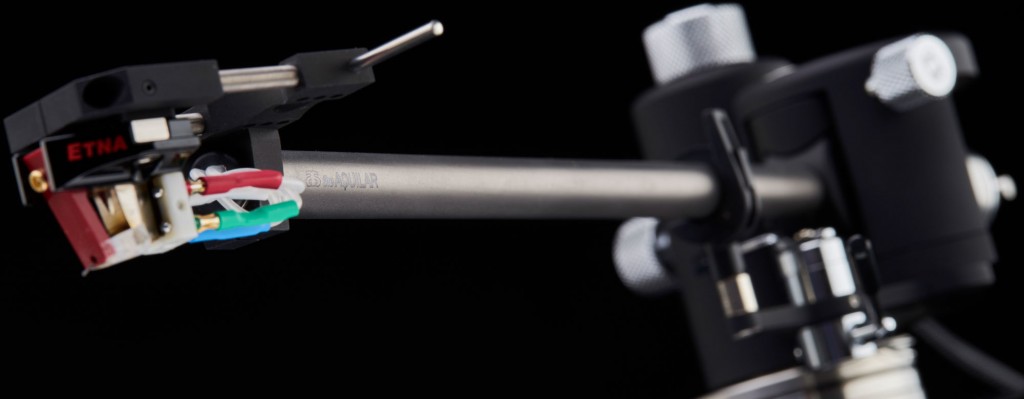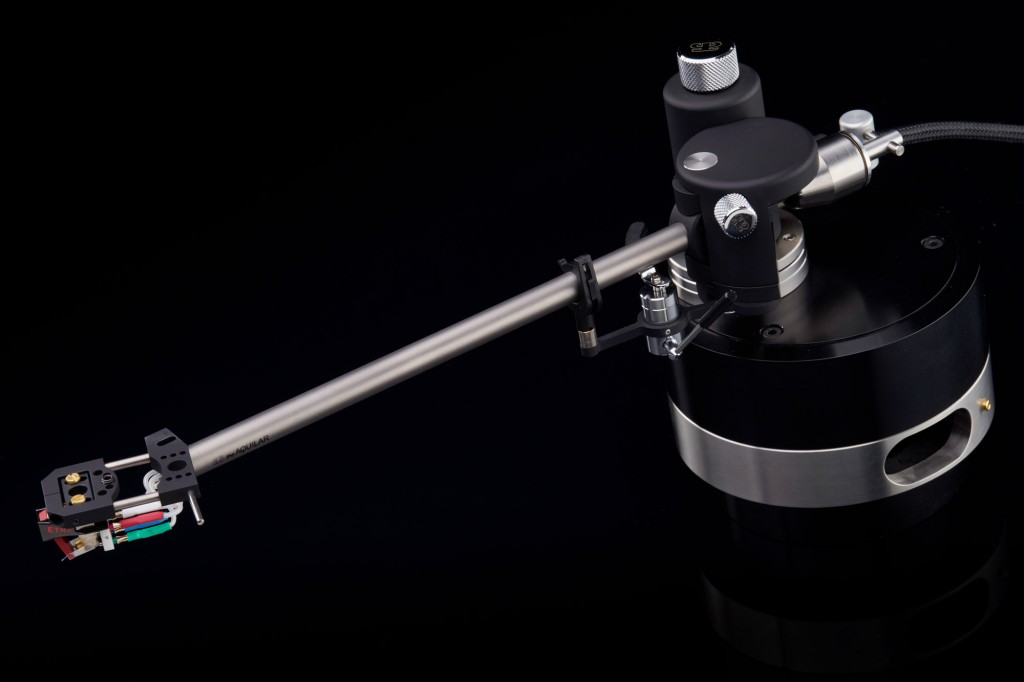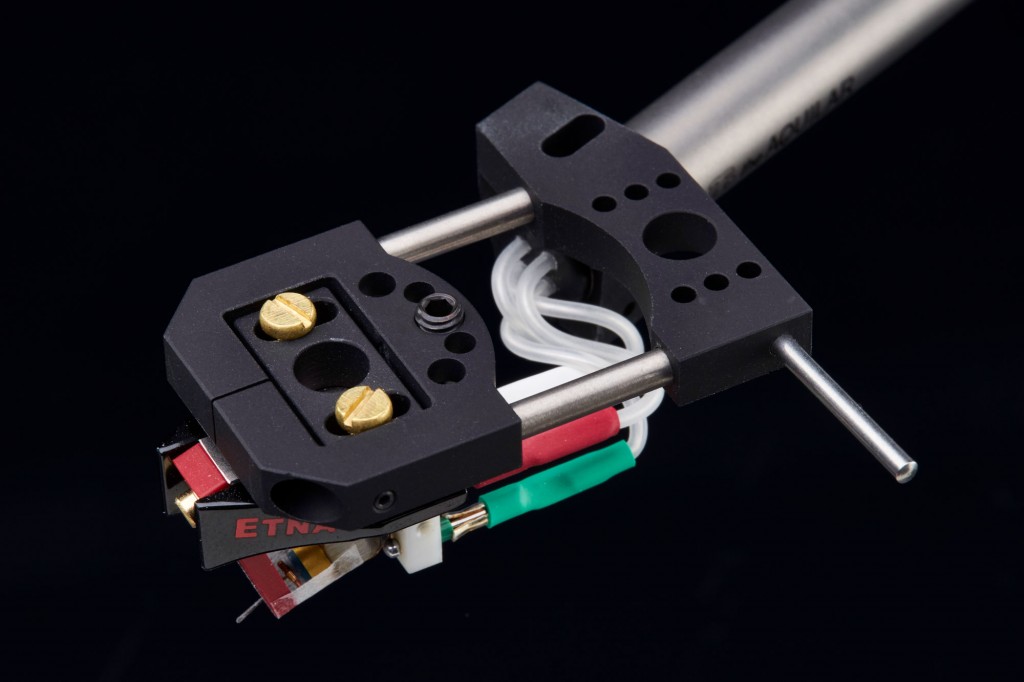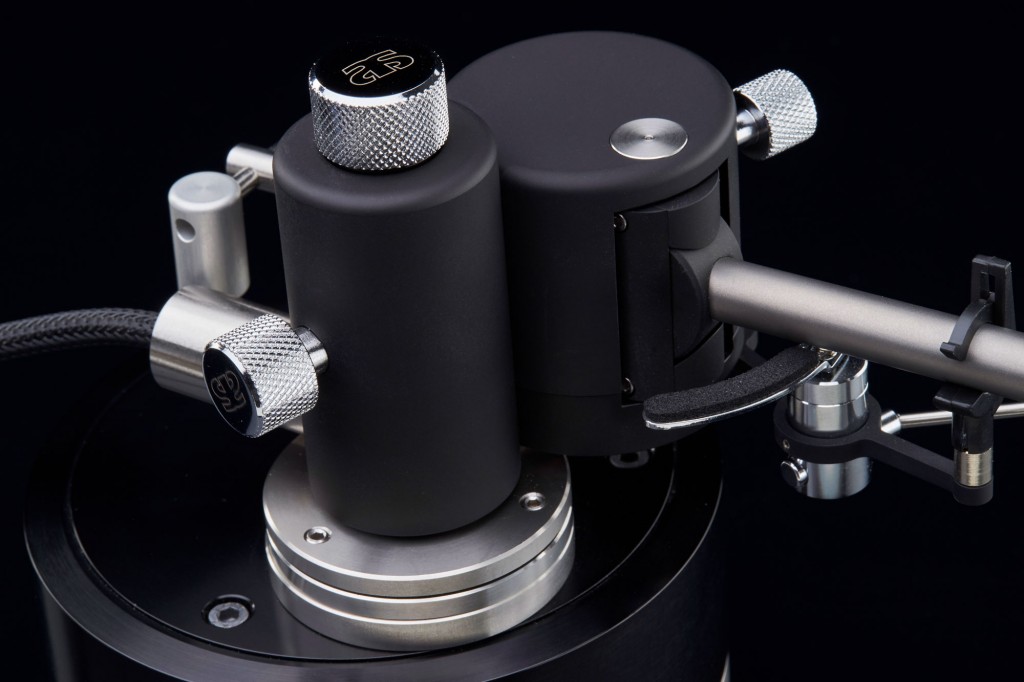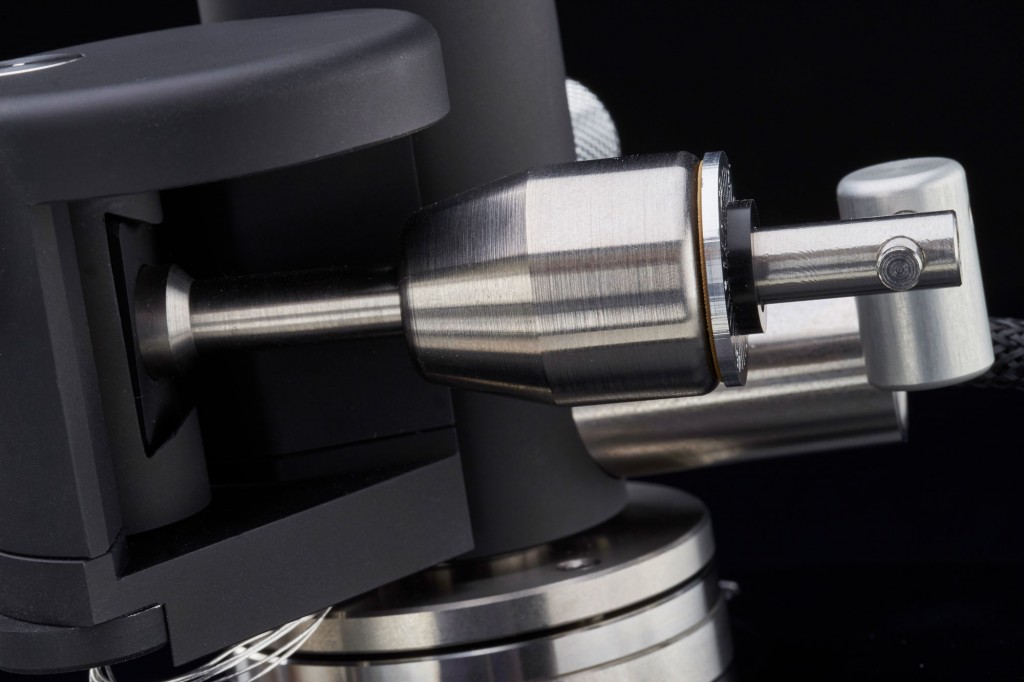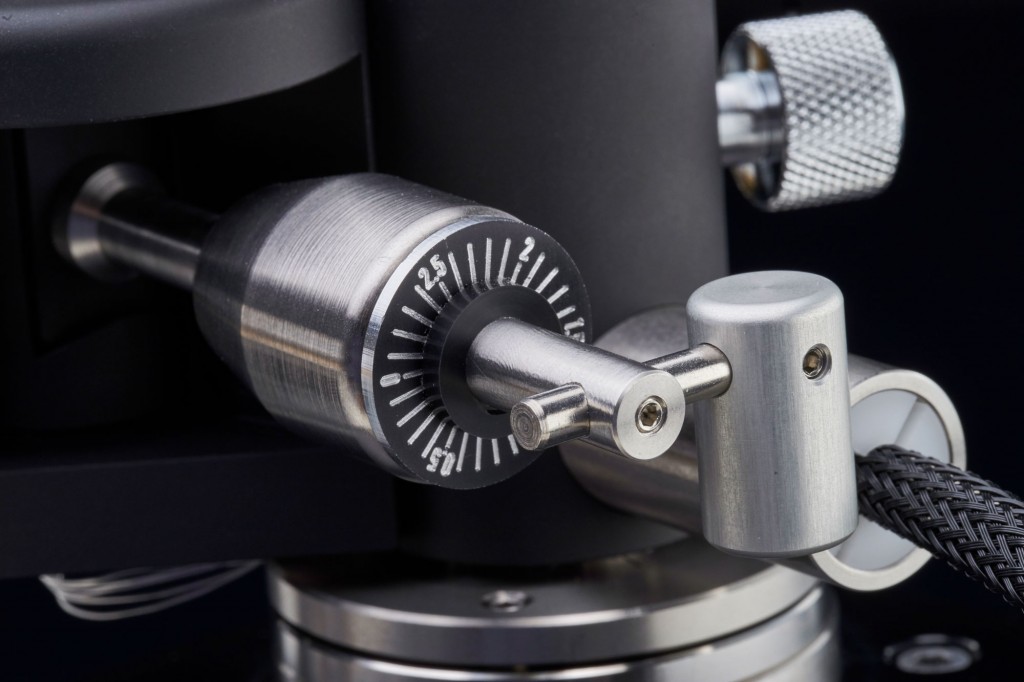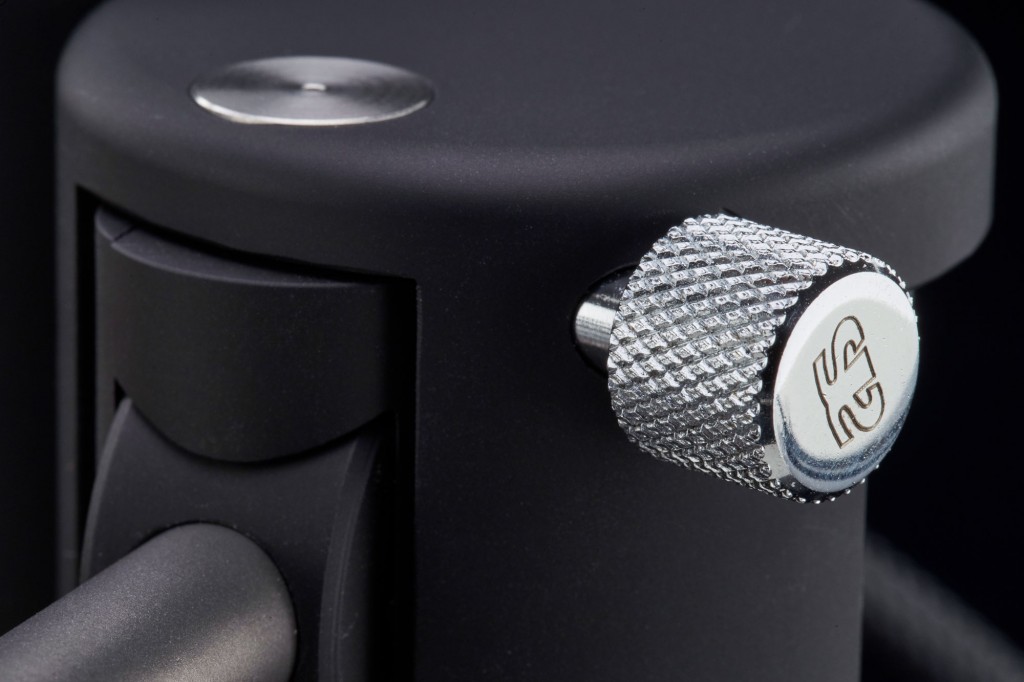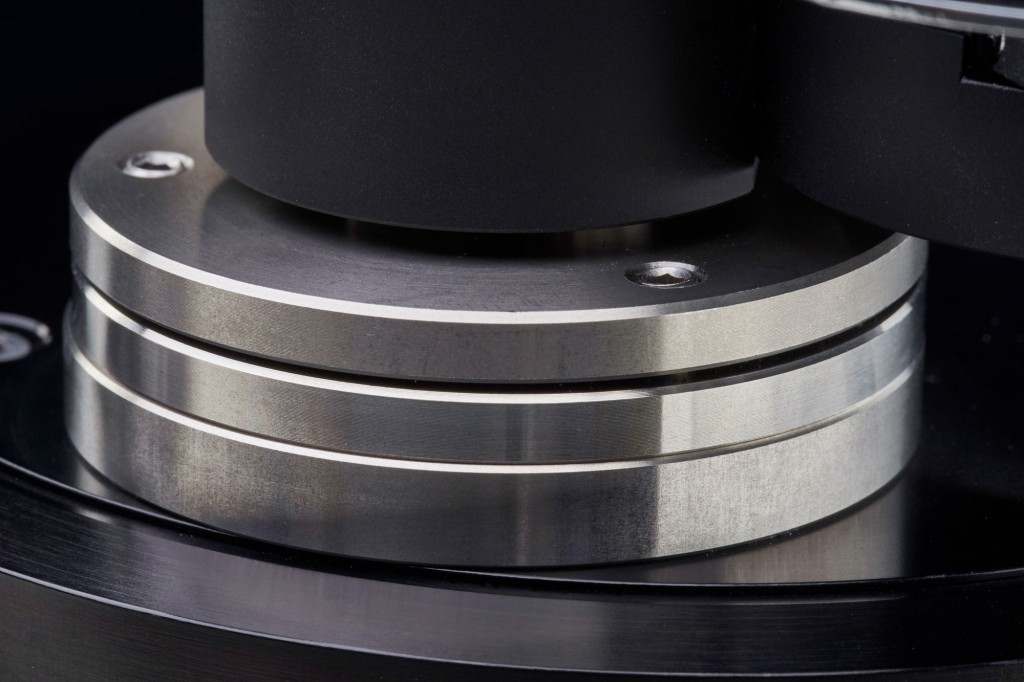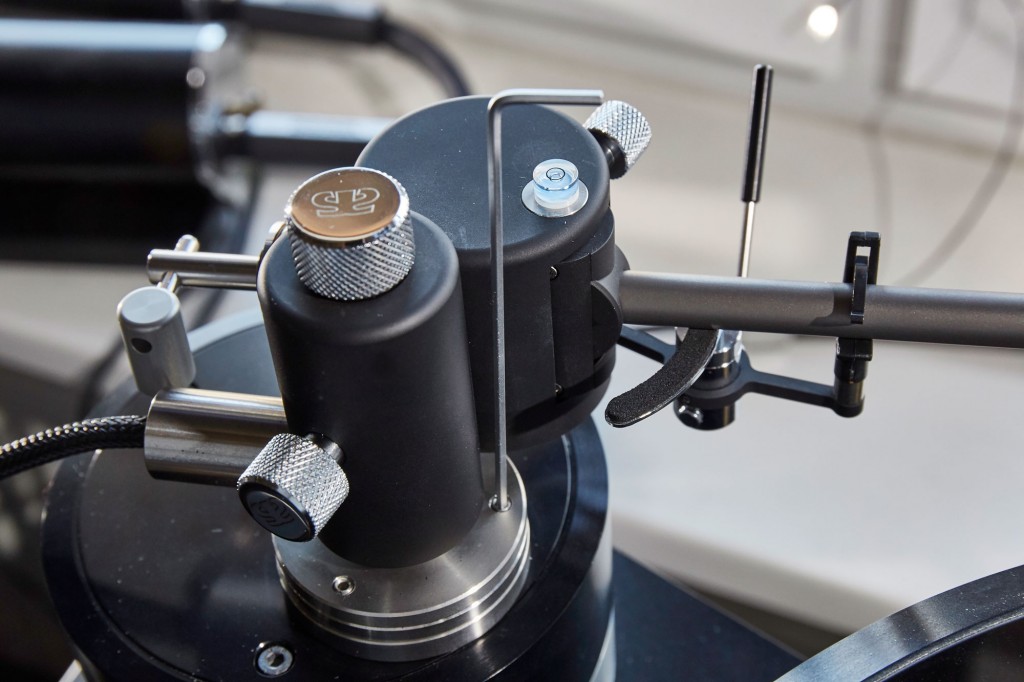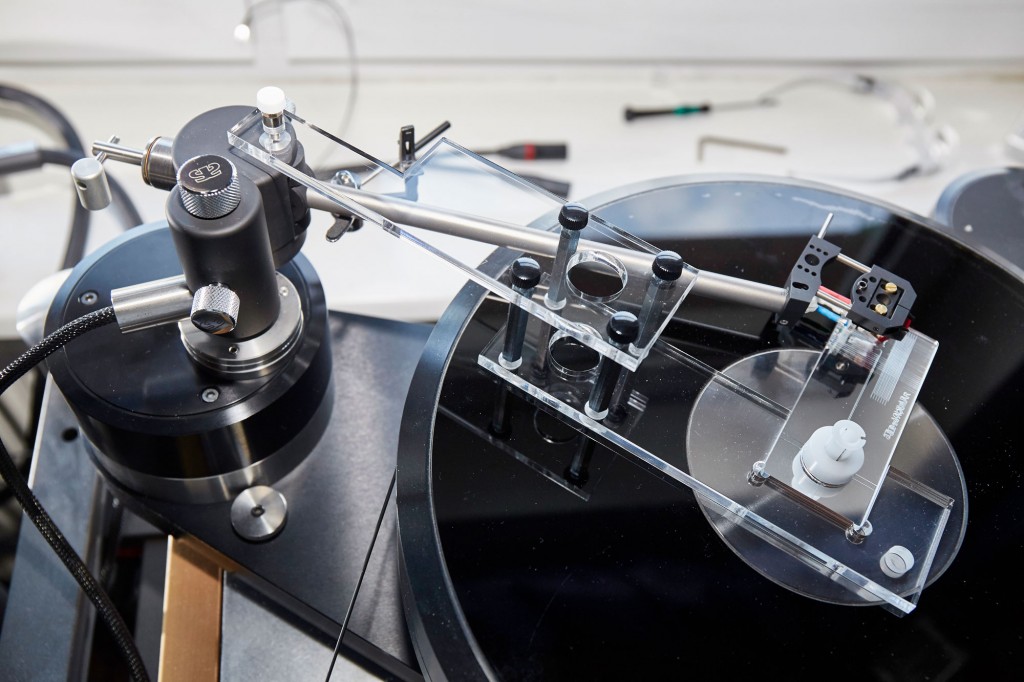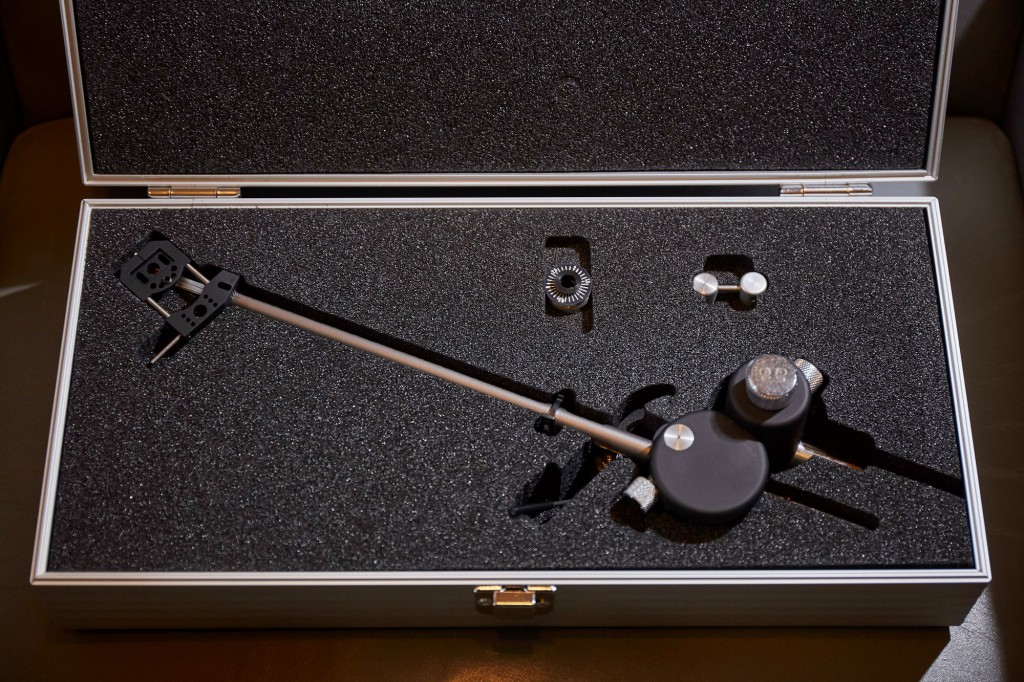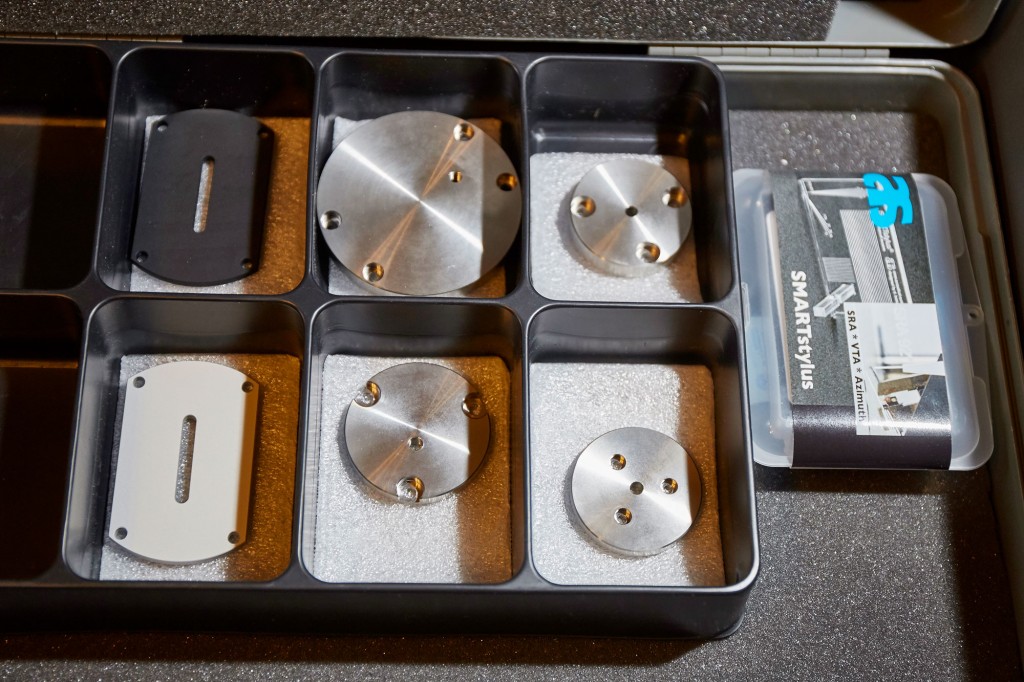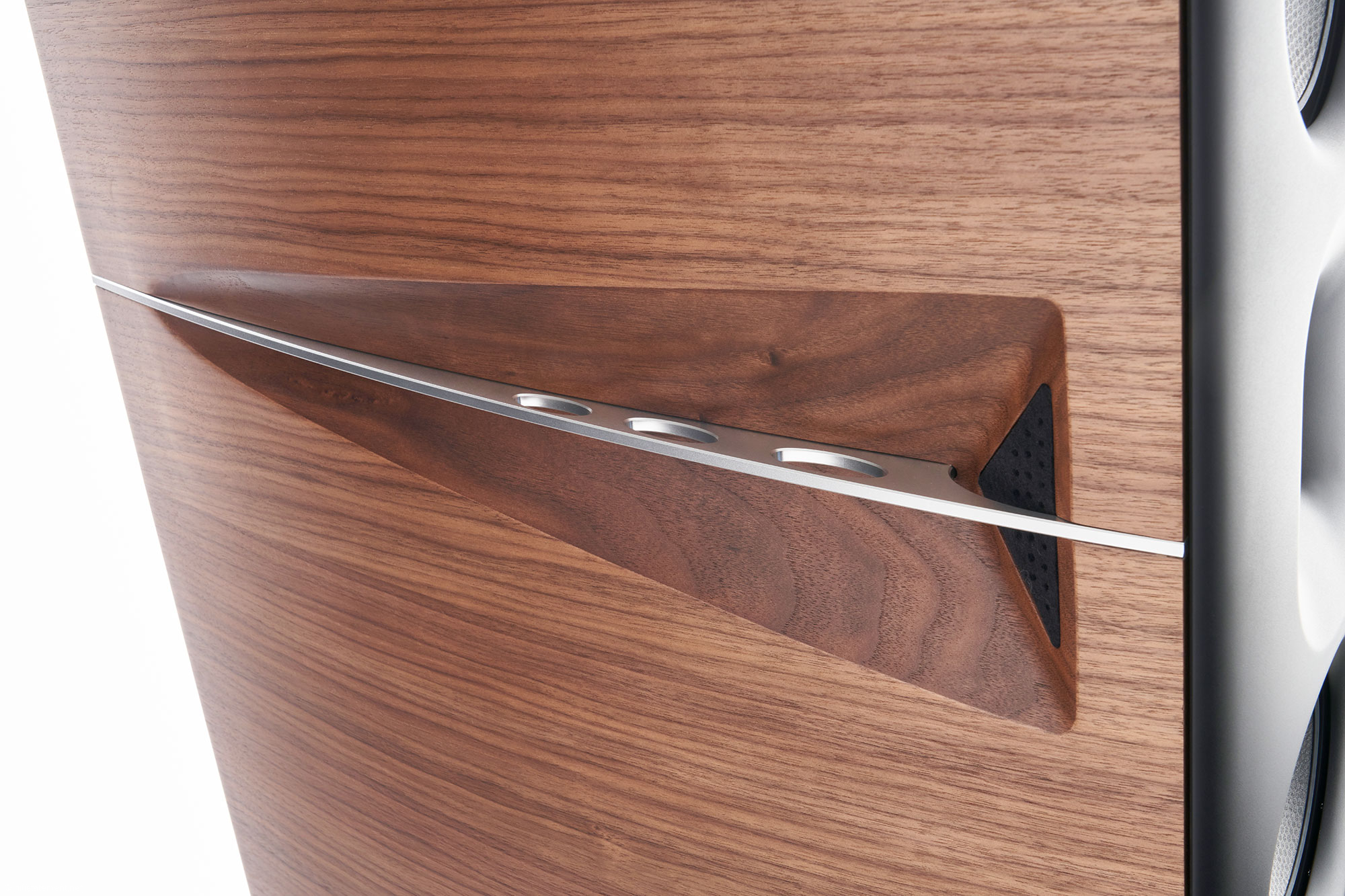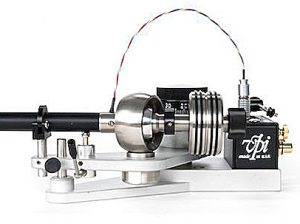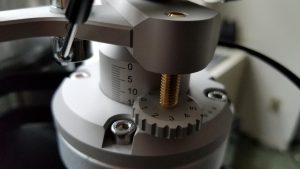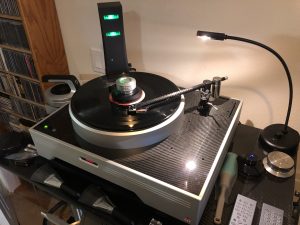I haven't introduced new tonearms to you for many years, which was due to the fact that—among the rest—really new solutions are extremely rare. Mostly, new models are about variations in the materials mix, in combination with different, known bearing kinds. With Acoustical Systems, however, this is different: The Aquilar tonearm is based on an entirely new calculated geometry.
However, before we turn to this, let me briefly introduce Acoustical Systems to you: Acoustical Systems is a family enterprise, founded by Axinia Schäfer in 1998. Meanwhile, her husband, Dietrich Brakemeier, an—in a positive sense—analogue-maniac, who at the very most will sometimes insert a CD when in the car, is employed there as a chief design engineer and looks after the technical developments. Axinia is responsible for the administrative and business sides of operations, as well as marketing, including website. The two traded during the first years with priority in New-Old-Stock-tubes and developed individual high-end system concepts for customers later on. While doing so, they introduced the Special Decoupled Platter (SDP) in 2009, a universal turntable upgrade of the special kind which, for example, makes the turntables of Micro Seiki, Verdier, or Brinkmann look much more imposing, and claims to catapult them sonically to a clearly higher level. The SDP virtually marks the transition to a reorientation of the company: From 2010 onwards, Acoustical Systems has been devoting itself exclusively to the so-called "analog front-end."
The Aquilar is an ideal visual fit for the Brinkmann LaGrange turntable. It also mates very well with Lyra Etna.
A year later, the UNI-Protractor and UNI-P2S were introduced, an unusual setting gauge for tonearm and cartridge, as well as the appropriate range finder for the tone arm. The following year, the quite unique arche-Headshell followed, which offers up-to-now unknown setting options, and whose design features also can be found in the Axiom tonearm introduced in 2013 and the Aquilar tone arm launched last year. Besides, the offer of Acoustical Systems still includes the setting gauge SMARTractor and various phono pickups like archon, astron, and aiwon, partly manufactured in limited edition only.
The Aquilar is the shorter and more affordable variation of the Axiom, the first tone arm from Acoustical Systems, which was recognized by a number of awards, above all in the Far East and—as Dietrich Brakemeier notes, not without a touch of pride—has found its place as tonearm of choice on the top models by Verdier, Kronos, Kondo and Continuum. But Acoustical Systems also calls the ten-inch variation Aquilar "Reference Tonearm"—understandable if one looks at the apparent design efforts or has the hidden ones explained. The externally simple looking tonearm wand consists, for example, of two concentric tubes made of titanium and carbon, which do not touch, but are braced against each other by the two end pieces. Thus, a rapid resonance transfer with maximum control of unwanted vibrations should be achieved. The delicate counterweight is manufactured on account of its high specific weight from a non-magnetic tungsten-nickel alloy which distinguishes itself through the attribute to virtually not allow itself to be stimulated into resonance.
The headshell allows adjustment of offset angle, overhang, and stylus rake angle
The arm is guided by four nano-bearings in three sizes, so that the axes of the two planes respectively move in bearings of different sizes and with different resonance behaviour. The most important criterion for the selection of the bearings was an extremely low starting friction torque: With the Nano bearings of the Aquilar, it should lie in the low 2-digit Newton micron metre (µNm) range—which means nothing more than that the arm can be set in motion with very low force from the neutral position. Acoustical Systems considers it important that the nano bearings are manufactured in Germany, like all remaining components of the arm. A large part of the suppliers is even situated in the local region, which makes the personal contact easier. Serially, the tonearm can be ordered with continuously guided, aged, highly flexible pure silver strands ending in balanced or RCA termination, or with the classic male DIN-connector. But differing customer requirements are also served.
After loosening the thumbscrew on the right, the height of the arm. and hence the VTA. is regulated with the rotary knob on top during operation – on-the-fly
Finally, thanks to the design adopted from the arche-Headshell, the Auqilar offers a wealth of setting possibilities. Of course, there is the adjustment of the vertical tracing angle (VTA) and the antiskating force, here generated by magnets without contact, and customised to the tangential curve, can take place during operation. The overhang and the azimuth belong with the Aquilar, as with most arms to the variable parameters. In addition, also the bearing plane can be aligned precisely with the Acoustical Systems, independent of the arm board or the base on which it is mounted. Changes in the offset angle and the stylus rake angle (SRA) are also possible with the Aquilar—at the headshell. Because Dietrich Brakemeier has also extensive knowledge of analogue Hifi history, he knows that above all with Japanese models, even with gimbal bearings, a device for lateral balance was for a long time regarded as indispensable. With this, it is being made sure first of all that both horizontal bearings are evenly loaded, which is a prerequisite for the extremely low starting friction torque to unfold its effect. More important, however, is that in each arm with offset, the occurring breakdown torque is compensated, because otherwise the skating force clearly increases. If one does not have the luck that Dietrich Brakemeier has installed his design on the home turntable with the desired pickup—here the wonderful Lyra Etna (HERE), then with this fullness of setting possibilities one relies upon informative operating instructions. With the Aquiliar, one of these is enclosed, which, on account of its rich illustration, is also easy to understand. Thanks to Axinia Schäfer!
The counterweight can be comparatively petite, since it consists of a tungsten-nickel alloy with high specific weight
Now on to the special geometry of the Acoustical-Systems arms and how it has originated: For UNI-DIN the desired distortion profiles were defined first, and then the geometry was calculated from it. Here the distortion in the external range, where a longer route is completed for the same amount of information than inside, may be higher than with the tangential curves calculated by Baerwald and Loefgren already at the time of shellac and mono vinyl records. Consequently, the distortions do not increase as strongly towards the inner groove for UNI-DIN. While the intensity of the distortions rapidly increases with the usual arms after the 2nd null point, the UNI-DIN geometry is designed so that the increase in distortion towards the label is happening quite smoothly. Dietrich Brakemeier has selected this solution, because the human ear reacts very sensitively to strong changes, but perceives gradual alterations less strongly. Therefore, the UNI-DIN was optimized not to achieve as low as possible average distortions over the entire groove, but to avoid a strong increase of the distortions above all towards the inner groove, which is more difficult to track because of the narrower radii—namely for acoustical-physiological reasons. After about the first 30 percent of the groove, the resulting distortions with UNI-DIN are claimed to be below the levels which are usual with the common standard geometries.
The Aquilar is one of the very few modern gimbal tonearms which have a device for the setting of the lateral balance
The considerations on the new geometry seem logical; the processing and the feel to the touch of the Aquilar are beyond any doubt. But how can the advantages of the Uni-Din be experienced? I can spontaneously think of a few records where it always comes to distortions near the labels: There was, for example, a dark blue ECM record with John Abercrombie on guitar, Dave Holland on the bass, Jack DeJohnette on drums and Collin Walcott, under whose name the record was released on tablas and sitar. With the last piece of the second side, unmistakable distortions repeatedly interfered at times, when I used conventional arms like Hadcock, Formula IV, or Linn Ittok, and these results even though my chain at the time, in terms of resolution, was far from what the current one has to offer. So I have put on Cloud Dance once more, have enjoyed the old songs of the second side, and have not perceived even a hint of distortion. Because it was so nice, I have for safety's sake still listened to the first side. Also again without any indication of difficulties—at least as far as "detected distortions" are concerned. With such fine resolution, so open and yet powerful and rhythmically thrilling, I had probably never perceived the songs before—if my memory serves me correctly.
With this screw, the anti-skating force is adjusted, which is generated by a magnet
Was I misled by memory with the choice of the record? As a precaution, I also put on once again after a long time the deep-blue ECM with the same line-up except Collin Walcott, namely Gateway: nostalgic musical enjoyment at the highest sound level, but on neither side even a trace of distortion. By the way, this cannot have been due to the pickup. At least in Ittok times I have listened almost exclusively to EMTs and they tracked 80 µm reliably. In comparison with that, the Lyra in general and the Etna in particular are rather little sensitive souls. Because they sound excellent in spite of less impressive measurements, I have stopped testing trackability almost completely during the last few years, at least when everything is right sonically.
Regardless of the armboard or base, the bearing plane of the tonearm can be aligned here
Even more critical than the two ECMs, one of my wife's favourite discs has remained in my memory, which I heard more often than I would have liked: A Perfect Match, where the get-together of Ella Fitzgerald with the Count Basie Orchestra in Montreux is entitled very appropriately. "Basella" with his sparing piano-intro and Ella's improvisation duels with the tenor Eric Dixon and trombonist Mitchell 'Bootie' Wood is truly a great musical moment, but was sonically difficult to endure because the groove is cut to less than 1 centimetre from the inner label—especially when Ella fully exploits the dynamism of her voice. Thanks to Aquilar and Etna, the energy of the song will now be an entirely positive experience. No trace of excessive sharpness or even distortion. So the Acoustical Systems arm must be doing something damn right!
This mini-spirit level helps in aligning the bearing plane. It is also produced in Germany.
Still quite impressed by the ECMs, I then immediately indulged in Ralph Towners' Blue Sun, but this time not only the really groovy "C.T.Kangaroo," but the whole album. It's just great how organic and harmonious the interplay of Towner with himself comes across, which Jan Eric Kongshaug has recorded on several tracks. Kongshaug created spaces on the console that have size, the instruments seem sculptural, and the dynamism enthusiastic. In the mentioned disciplines, the Aquilar and the Etna offer a good bit more than I expected from the familiar record. The Acoustical Systems provides an enormous blackness, before which Towner's rhythmically accented songs are presented all the more impressively. The playback has grip, three-dimensionality, and inner peace, and yet—or because of that?—it is still full of vitality and playfulness. In the midst of the almost unbelievable new developments in the digital domain, I would have almost forgotten about how tremendous and involving records can sound – at least if they are tracked by such a high-carat duo like Etna and Aquilar.
The two perform in a similarly convincing way for the Stereo Laboratory reissue of the London 6790, Berlioz Symphony Fantastique with the Chicago Symphony Orchestra under Georg Solti. The orchestra plays on a wide and very deep stage, stretching beyond the stereo base, and the dynamism can nearly terrify—an appropriate volume being required. The imaging also remains absolutely stable in fortissimo passages, and the bass range is fascinating through its pressure and definition. This is quite an experience!
This elaborate gauge is part of the package.
I will not be able to get by completely without one or the other of my test discs. The fact that the Aquilar has something special to offer in the bass range is now certain: Here differentiation, colours and force form an admirable alliance. This is proven particularly strongly with Jonas Hellborgs "Drone" and "Little Wing" on the album Elegantly Punk. The successful combination of energy, depth, quickness, and precision has already made the Aquilar in combination with the Etna an exception. But this is still complemented by a steadfast stability in the imaging, and in spite of the no doubt worn out grooves, still—relatively—an acoustical calm, which I do not remember. The Acoustical Systems is a tremendously dynamic stoic. Or rather a very stoic dynamicist? In any case: The Aquilar is simply one of the best arms that I have ever had the pleasure to hear. And this underlines Jonas Hellborg's "It's The Pits, Slight Return" once again quite emphatically: So much pressure from such a blackness is simply unique!
Of course, the Aquilar is delivered in an appropriate package!
STATEMENT
The Uni-Din- geometry of the Aquilar is completely convincing: it also masters passages cut close to the label with high level signal absolutely easily. However, its mechanical integrity distinguishes it even more. In spite of dynamic top performance, it illustrates the musical events absolutely solidly at any time on an enormously big—imaginary—stage. And all that happens before an absolutely black background. The combination of all these virtues makes it one of the most worthwhile tone arms in general!
PS: I'd love to immediately inquire with Acoustical Systems, when an Axiom is available—although I cannot imagine, even with the best will in the world, what it could do even better.
Acoustical System holds a lot of base plates available so that the Alquiler can be easily mounted on suitably prepared bases or arm boards
System
- Brinkmann LaGrange With Tube power supply.
- Thales Symplicity II.
- Lyra Etna, Einstein The Pickup.
- Einstein The Turntable's Choice balanced, Blue Amp Model 42.
- Einstein The Preamp.
- Ayon Epsilon With KT150.
- LumenWhite DiamondLight Monitors, Diapason Altera.
- HMS Gran Finale Jubilee, Audioplan Powercord S, Göbel High End Lacorde Statement, Swiss Cable Reference Plus.
- PS Power Plant, Sun strip, Audioplan Powerstar, HMS wall outlets, Acapella bases, Acoustic System feet and resonators, Artesania Audio Exoteryc, Harmonix Real Focus, bfly Bases and feet.
Product information
- Acoustical Systems Aquilar – 10" Reference Tonearms, geometry: UNI-DIN
- Effective length according to Loefgren A: 254 mm
- Fulcrum distance to turntable center: 238 mm offset angle variable, about 17° - 25°
- Overhang: variable, about 5 to 16 mm
- Effective moving mass: 11,4 g
- Internal wiring: highly flexible, aged pure silver strand
- Resistance of the internal wiring: 0,9 Ohm/m
- Capacity of the internal wiring: 25 pF/m
- Possible Cartridge weight: 5,2 to 30 g
Adjustment ranges
- Setting of the level of the bearing: +/- 6° horizontal
- Height adjustment of the tonearm: 15 mm
- Setting of the offset angle: +/- 4°
- Overhang: max. 11 mm
- Azimuth adjustment: +/- 8°
- Setting of the stylus rake angle: 97° to 84°
- Setting of the vertical tracing angle: 28° to 14°
Retail: 7580 Euro
acoustical systems
Axinia Schäfer
Alpenstr. 26
86935 Rott




